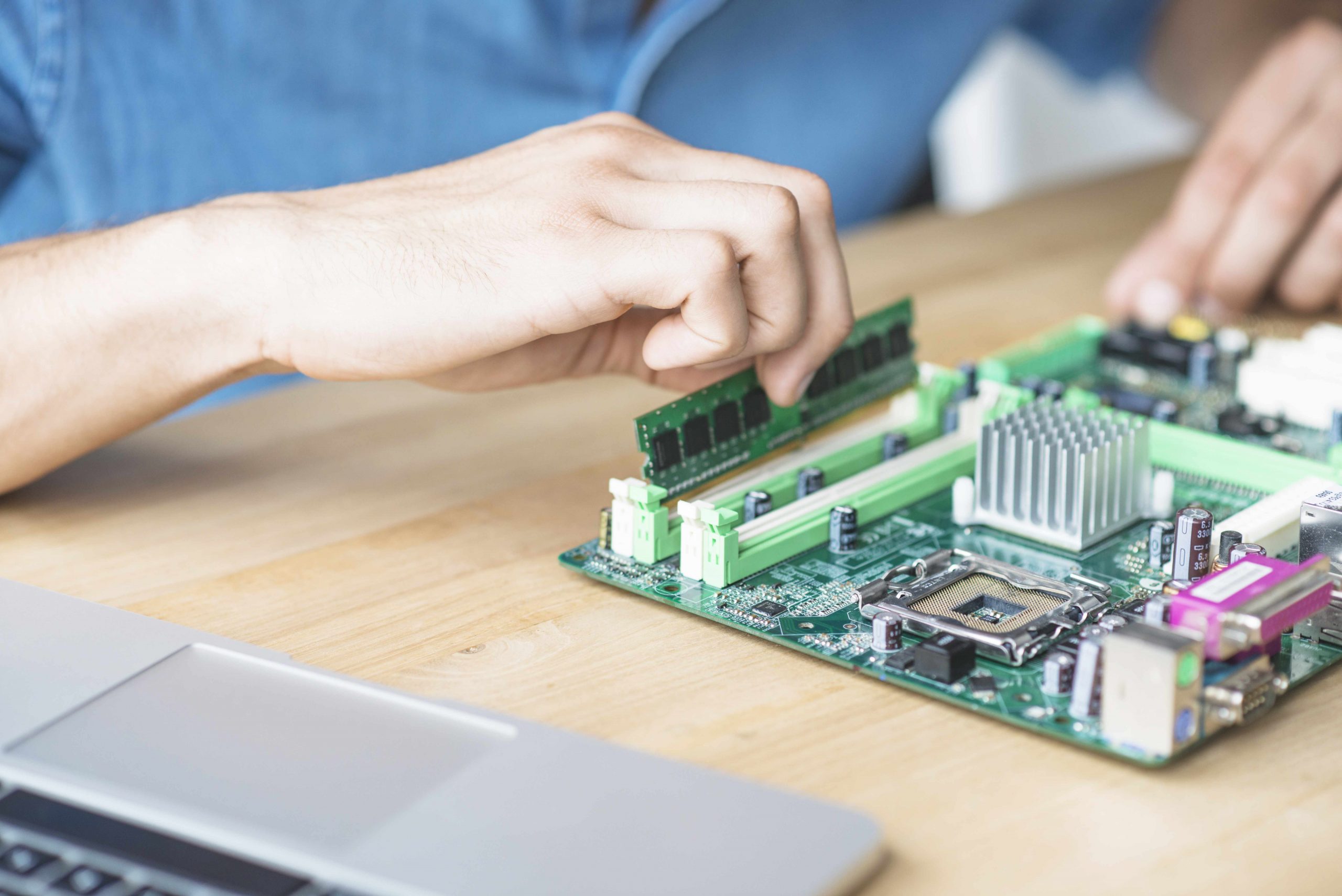System memory, or RAM, is as essential to video editing as the CPU and GPU. This everything you need to know when buying RAM for your video editing PC.
System memory, also known as random access memory (RAM), is the fastest kind of memory device on any computer — magnitudes faster than even the fastest NVMe SSD. With all that speed, however, comes a caveat. RAM is considered “volatile memory,” meaning it doesn’t hold onto the stored contents after the computer reboots, which is why RAM isn’t used for permanent storage.
When comparing computer memory with human memory, RAM is like short-term memory, while HDDs and SSDs are more like long-term storage. Like short-term memory, RAM is great at quickly finding the information you need when you need it because it can store information and instructions needed to run the software you’re using.
The faster RAM is, the faster it’s able to deliver information to the CPU. Aside from RAM speed, other factors, like timing, CAS latency, and storage, impact the performance of RAM. Though RAM sticks may all look the same, to an extent, it’s important to dig deeper before upgrading your computer’s RAM.
If you’re building a PC for video editing, Photoshop, or other creative software, you’ll want to allocate a decent share of the budget toward RAM. Creative software is notoriously memory-hungry; lacking sufficient RAM is likely the reason why software like Premiere Pro keeps crashing. But if RAM can’t be used as storage, what is RAM good for, and how does it affect video editing? The answer to that and a lot more lies below.
Why Do You Need RAM?
Every computer, from budget Chromebooks to MacBook Pros, uses RAM. Along with the CPU and GPU, system memory is an essential component. System memory is a lightning-fast type of memory that temporarily stores information requested by the memory controller within the CPU to operate the software. Every application has a set of instructions and data that it needs in order to function, and the quicker the CPU can access those instructions or files, the faster the software will function. That’s why faster RAM, which is measured in megahertz (MHz), is always better, as it can retrieve data at a faster pace, which translates to faster and smoother software.
Having more RAM is also good. With more RAM, computers are able to run more applications simultaneously without severely impacting computer performance. Creative software especially can be RAM-intensive, requiring more RAM to load large files like RAW images or 4K videos while you’re editing. When you don’t have enough RAM, the software will slow down to a crawl, or it may freeze. Worse, running too many programs on insufficient RAM can cause computers to crash because there’s not enough memory to store all the data required by the software.
What Does RAM Have to Do with Video Editing?
Like all applications, video editing software requires RAM to store memory instructions, files, and other assets temporarily. But video editing software, and most other creative applications, is different from normal productivity software. Creative programs are exceedingly demanding of all PC resources, though slow or insufficient RAM can create a bottleneck.
With video editing software, the RAM’s speed dictates how quickly the software starts up and how long it takes to load new clips and effects. More importantly, RAM speed impacts playback and, therefore, the timeline. That’s because files are temporarily stored in system memory for the purpose of smooth playback and timeline scrubbing. However, system memory may have a hard time loading clips or the timeline if the RAM isn’t fast enough or if the source files are too big. Slow RAM can cause the timeline to keep pausing, forcing playback to stop and start as system memory loads the file and sends it to the CPU.
Additionally, having more RAM is beneficial in video editing as you can temporarily store more video files at once — like 4K video files, for example — to allow for faster, more seamless timeline scrubbing. The higher the resolution of the file, the more system memory it takes to load one second of playback. According to this article, loading just one second of a 1080p video at 30 fps requires roughly 178 MB of system memory, while loading one second of an 8K clip at 30 fps requires a whopping 2,847 MB of system memory.
How Much Ram Do You Need?
All NLEs have minimum and recommended system requirements that let you know what hardware they need. How much RAM you have installed dictates which kinds of video files you can work with. If you’re working solely with HD media — i.e., 720p and 1080p — and are not planning on using a lot of effects, you might get away with minimum system requirements. However, if you’re working with 4K and 8K media or are planning on using effects, the recommended requirements are a must.
Every application has different minimum requirements, but here are the minimum system requirements for the top three editing applications:
- Adobe Premiere Pro
- RAM required (Windows):
- Minimum: 8GB
- Recommended: 16GB for HD media; 32GB for 4K and higher
- RAM required (macOS):
- Minimum: 8GB
- Recommended: 16GB for HD media; 32GB for 4K and higher
- RAM required (Windows):
- DaVinci Resolve 18
- RAM required (Windows):
- Minimum: 16GB for HD media
- Recommended: 32GB for 4K and higher
- RAM required (macOS):
- Minimum: 8GB for HD media
- Recommended: 16GB for 4K and higher
- RAM required (Windows):
- Final Cut Pro (macOS only)
- RAM required (macOS):
- Minimum: 4GB for HD media
- Recommended: 8GB for 4K media
- RAM required (macOS):
More RAM and faster RAM are always better, but you’ll have to weigh which one is more important to you if you’re on a budget. Faster RAM will result in snappier, seamless software experiences, while more RAM will allow you to run more software simultaneously.
Additional RAM Tips and Info You Need to Know
System memory may occupy a physically small space inside your computer, but there’s a lot to RAM that you may not know. For example, standard motherboards use dual-inline memory modules (DIMM), while laptops use small outline dual-inline memory modules (SODIMM). The slots on the motherboard for RAM sticks are called DIMM slots, and not all RAM is compatible with motherboards. The memory controller on your CPU decides the type, size, and speed of RAM that is compatible. For veteran PC builders, this information is old hat, though it’s invaluable information that many builders find out the hard way after spending way too much money on incompatible hardware.
What Do the Numbers on a RAM Stick Mean?
When you’re looking for RAM, you’ll see something like “DDR4-3200” and “.” So what does it mean?
What Does DDR Mean?
The first part of the first name refers to the generation of RAM, so DDR4 means it’s fourth-generation RAM. DRR4 is the most commonly available kind of RAM today, though DDR5 will soon surpass it in the coming years.
What does RAM Frequency Mean?
The number attached to DDR4, which in this case is “3200,” refers to the speed of the RAM measured in megahertz. It explains the amount of data transfers the RAM stick is capable of every second. In this case, that would be 3200 megatransfers per second or 3200 MHz. When talking about RAM, most people use megahertz rather than megatransfers, and it’s what you’ll see on RAM packaging.
What Does PC4 Mean?
The second number, PC4-25600, refers to the theoretical peak transfer rate, which would be 25,600 MB per second. To put into perspective how fast that is, the SanDisk Pro NVMe SSD — considered one of the fastest SSDs on the market — has a max transfer rate of 2,000 MB per second. That would make DDR4-3200 PC4-25600 13 times faster than the fastest portable SSD on the market. And that’s nothing compared to DDR5 RAM, the newest generation of RAM that’s soon to eclipse DDR4 RAM.
What Are Memory Timings?
Memory timings are another set of numbers you’ll spot alongside the numbers above, and they refer to the timing values associated with RAM. The first number refers to CAS latency, a measurement that explains the number of cycles it takes for the RAM to prepare information the memory controller requests. This number is often associated with the speed of the RAM, with lower CAS latency numbers equating to faster RAM. However, this isn’t always true. While a lower CAS latency number is good, high-frequency RAM can offset a high CAS latency. So while it may take more cycles to prepare information, higher-frequency RAM can make up for it by transferring more data at a faster rate.
Activating Your RAM’s Full Potential with an XMP, EOCP, and DOCP Profiles
When you buy RAM, the speed listed on the packaging is not the default speed you’ll get when you place the RAM sticks in the DIMM slots. RAM manufacturers aren’t lying to you, though. They expect you to know that a setting in the BIOS unlocks the speed advertised on the package.
Instructions vary because motherboard manufacturers all have different names for it, but whether it’s an XMP or DOCP profile, they all work the same. These profiles overclock the RAM to get it working as promised. It’s not difficult to do, but if you’re unaware of this, you might feel like you’ve been swindled. If you don’t turn it on, RAM will run at the default speed — DDR4 memory defaults to 2133 MHz.
Taking Advantage of Dual-Channel Memory
Another thing RAM manufacturers don’t tell you about is dual-channel memory. This is crucial for faster RAM because system memory typically transfers data to the memory controller via one lane, or channel. Dual-channel memory, however, adds an additional lane, doubling the amount of data that can be transferred simultaneously. To turn this on, you’ll have to do two things: allow for dual-channel memory in the BIOS and place the RAM sticks in the correct DIMM slots. Instructions for both vary by motherboard, but you can find the information within the motherboard manual or on Reddit.
Upgrading Your RAM
If you’re tired of your PC freezing up or crashing every time you edit a video, it’s probably time to buy more RAM or upgrade to a better kit. While it can be pricey, it can also be cheaper than buying a new CPU or GPU, and it’s much easier to install. You just have to remember that not all RAM is built the same. Capacity, speed, timings, and even the manufacturer are all factors worth considering. I’m partial to Corsair’s Vengeance LPX RAM sticks, which offer a lot of value at an affordable price, but you should do some digging of your own. With this knowledge in hand, you can now shop for RAM confidently. Just remember to turn on the XMP profile and dual-channel memory to get the most from your expensive RAM kit.
Looking for filmmaking tips and tricks? Check out our YouTube channel for tutorials like this . . .




